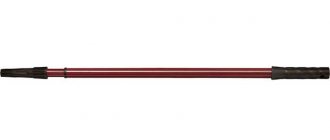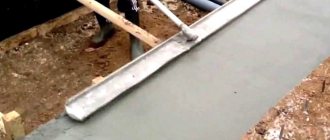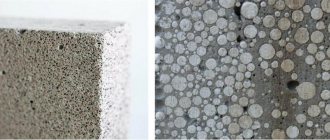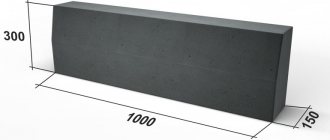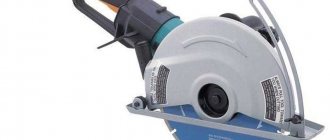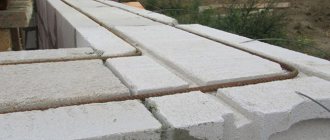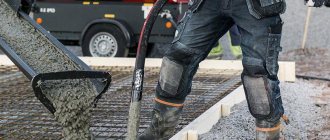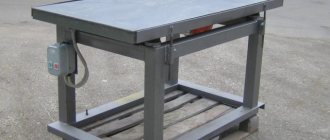The use of a professional tool for screeding concrete mortar guarantees a perfectly flat surface. The toothed trowel eliminates the accumulation of excess moisture and minor irregularities, thus strengthening the surface of the concrete coating. The effectiveness of using tools at industrial facilities is ensured by the use of vibration devices for compacting concrete mortar.
When installing a special, additional blade on the working plane of the device, the scraper method is used, driving liquid from the concrete.
Telescopic handle for ironing iron
Professional modifications of manufactured instruments are often equipped with an easy-to-use telescopic handle, which has the function of expanding and connecting additional segments.
The handle is attached to a plate made of metal or other durable material. The plate is a working surface for smoothing concrete. The length of the working plate for smoothing reaches 1 meter, and the length of the telescopic handle is up to 12 meters. The operating principle of the tool, equipped with a telescopic handle, is based on the method of using a conventional mop for cleaning floors.
Often, when the length of the working plate increases, the device is equipped with 2 handles and movement is carried out when 2 people work together.
The maximum quality of concrete leveling is achieved by sequential movement in perpendicular directions and in zigzags.
The advantages of a smoothing iron with a telescopic handle are obvious:
- Man-hours are saved when leveling large areas of laid concrete mortar.
- Better surface treatment, which achieves almost perfect smoothness, removes leaking liquid, and prevents the appearance of a bubbly, brittle hardened layer of concrete.
Types of trowels for concrete
The professional concrete trowel is made of stainless steel and aluminum, due to which it has a long service life and is not subject to corrosion.
A device made of wood requires periodic drying, since wood is deformed by moisture and the working base may be distorted. Therefore, the wooden plate is treated with a special hydrophobic compound, which is periodically applied after the device has dried.
The edges of the working blade have different shapes and are also equipped with a double profile. Professional models are equipped with a bubble level, making it easier to control the screed.
Important: experts recommend buying a product made of stainless steel or aluminum if you are planning a large scope of work, as well as if you use the tool frequently. Because a perfectly smooth blade and lack of deformation guarantees its long service life and the quality of the work performed.
Metal for painters
With the advent of a professional trowel for painters, the use of a spatula became irrelevant. Because a professional metal device for painting work has greatly simplified the work process with significant savings in building materials.
In addition, it is very convenient and simple to apply putty to the ceiling area; you just need to smooth the applied material along the working plane, smoothing it evenly.
Leveling and sealing individual cracks, holes on walls and ceilings with a trowel is very convenient, especially with local unevenness. In addition to metal devices, plastic smoothers are also manufactured.
Plastic
Plastic tools used for painting work provide a perfectly smooth surface because they have an increased level of slip.
The plastic smoother is made of heavy-duty plastic; thanks to the technological properties of the material, it has a long service life, is resistant to friction and the action of chemical reagents. The advantage of the tool is that it has a favorable low cost.
Smoothing - spatula
The plastering device has an additional name - spatula-trowel, this is due to its appearance. It is a work plate equipped with a handle. The width of the working plane is 20 cm, the length is 30 – 50 cm. The tool is used for leveling drywall joints, when preparing the working area for plaster and directly during the plastering process.
Serrated
A toothed trowel, which has a lighter shape, is used when laying ceramic or faience tiles; it is also convenient when applying glue when performing finishing work, therefore it is considered a universal device, since it can replace a comb and spatula. Its working plate is made of stainless steel and has serrated edges on both sides. The handle to make the tool lighter is made of plastic.
Plastering
Plaster trowel is mainly used for smoothing work areas after the process of applying plaster mortar. When finishing a structure or room, before painting, using a plastering device, you can achieve the effect of ironing, that is, spraying cement onto plastered walls.
When choosing a tool, it is important to pay attention to its parameters, since the size of the device determines the performance of various types of work. The use of a trowel for decorative plaster allows you to create a surface texture that is varied in appearance. When working with decorative plasters and applying the finishing coat, a trowel is an excellent assistant for leveling dried mortar, as well as creating the effect of a marble coating.
Swiss
The tool is used mainly for finishing the facades of buildings and structures. Since it has a greater length, unlike others, it is therefore used for uniform distribution of the solution over large working areas followed by smoothing.
Steel smoother
The device is equipped with teeth, very convenient in the process of applying and smoothing glue when laying ceramic tiles, both on vertical and horizontal surfaces. The device is most popular when laying tiles in the kitchen, bathroom and toilet.
IMPORTANT: when choosing a gear tool, experts advise paying attention to the size of the teeth of the working plate. Since when laying small tiles it is more convenient to use a tool with a 4x4 mm tooth, when laying large tiles it is recommended to choose a plate with 6x6 mm or 8x8 mm teeth.
For concrete telescopic
The concrete trowel with telescopic handles has 2 types of working plate edges: scraper and channel.
- Channel blades perform light screeding of concrete that has not yet hardened and is sufficiently plastic.
- Scrapers are mainly used at the stage of solidification of the solution in the interval from 1 to 3 hours, to control the level of the plane and remove protruding liquid.
The telescopic handle allows you to move the work plate as efficiently as possible.
floating
The working element of the tool, made of aluminum, equipped with a hinged, floating handle mount, is convenient and lightweight when distributing a moving layer of concrete. Floating channel devices allow you to achieve optimal results.
The tool is used when gluing wallpaper to smooth it and remove air; it has various configurations and is made of plastic.
Depending on the shape, the product is used:
- for working with heavy wallpaper, on large areas;
- for leveling wallpaper in corners and hard-to-reach areas.
The device is also used when leveling liquid wallpaper, evenly distributing the material over the plane.
Concrete trowels - general information and application
A product made of wood must be well sanded to avoid errors during the work process.
Design features and operating principle
The tool, used for working in small areas, looks like a trowel for a mason or a trowel for plastering work, to which a handle is welded by electric welding.
A product made of wood, as well as a metal device, copes with its functions perfectly. The smooth working plane has rounded edges, allowing it to move smoothly across the surface. The device is moved in zigzags to improve the distribution of the solution.
The use of manual slatted trowels for laying concrete
Manual rack and pinion devices are often used in small areas, are made of light aluminum alloys, and are equipped with a cable gearbox that changes the angle of inclination of the working plate with rounded edges. The change in the angle of inclination depends on the mobility of the freshly poured solution, the maximum value is 60 degrees.
Channel trowel for correcting the surface of fresh concrete
The channel device is mainly used for simple corrections and leveling of concrete pavement with the angle of the installed handle up to a maximum of 30 degrees. The optimal width of the adjustable working area is 3 meters.
The complete set is complemented by a toothed nozzle, which forms expansion joints that separate the surface of the laid mortar, which allows you to simultaneously level and create expansion joints. Thus, the tool reduces the cost of the work performed and its labor intensity.
The device is made of aluminum alloys or stainless steel; the mirror working plate has increased resistance to corrosive processes and chemical reagents.
Scraper
The scraper type of tool is designed to collect and remove escaping liquid. It eliminates tubercles well and controls the horizontal level of the plane. Rotating the handle increases or decreases the angle of the blade to facilitate the alignment process. The length of the handle reaches 6 meters, the maximum width of the working area is also 6 meters.
Serrated
The tool has a number of undeniable advantages:
- light weight, since the blade is made of aluminum alloy;
- wide range of blades;
- used over large areas;
- strength and durability of the structure.
To perform the work efficiently, you should prevent the device from immersing itself in the concrete mixture by constantly holding it on the surface, sliding along it.
Making at home from wood
If you don’t have the money to buy a device, but you urgently need a smoothing tool, it’s quite possible to make it yourself. Of course, it will not be possible to create a powerful device, but it is quite possible to make a simple and convenient ironing iron to perform a one-time task.
Working cloth
To create a profile for a construction tool, you need an edged board with a smooth surface. The length of the lumber should be from one to two meters: the parameter will depend on the size of the area that needs to be concreted. Thickness – no more than 30 mm, otherwise the smoother will turn out heavy, and its handle will sag. Further:
- Sand a piece of wood flat on both sides well. Round off the bevels of the end edge of the material;
- Check the work surface for smoothness using sand or dry soil. If, after running over the granular substance, there are still irregularities on the board, sand the future profile again;
- to maintain smoothness on the working blade, treat with a solution of rosin or tar;
- the working surface can be made of duralumin. The alloy of aluminum and copper is lightweight, ductile and has a long service life, so a tool made from this material is very light and easy to use.
Pen
The holder for the mortar leveling tool is made of timber. A design with a very long holder will turn out to be bulky and inconvenient, it will not be easy to work with it, so the handle should not exceed 5.5 m. To operate the smoother during construction work in small areas, you can use holders from a shovel, rake or fork. When working with standard timber, the edges need to be rounded with a planing tool and sanded. Further:
- Attach the prepared holder to the work surface at an angle of 60 degrees. For fixation, use two wooden braces screwed with screws. Self-tapping screws should not protrude onto the surface of the profile so as not to disturb the smoothness of the product;
- for a working sole of more than one and a half meters, two handles must be attached. Such a structure will be easier to manage, but it will no longer be possible to cope with smoothing the concrete alone;
- An option for high-quality fixation is a structural unit in which the elements are connected to each other using a hinge. In this case, the maneuverability of the tool increases several times. The holder must be secured to the hinge at an angle so that it does not dangle, but freely changes the angle between the main edge and the plane.
Trowels
In large production areas, when pouring concrete, special construction units are used to level it - mechanized trowels for concrete mortar.
The unit allows you to achieve a perfectly smooth surface.
- To do this, at the first stage, the device rubs the concrete with a disk with a working diameter from 600 mm to 1200 mm, eliminating the initial roughness and unevenness of the solution.
- Then blades with rounded edges are attached to it, and for high-quality work, the angle of inclination of the blades, which are installed horizontally, is adjusted.
- As the concrete dries, the angle of inclination increases. The angle can be changed by adjusting the tilt from 0 degrees to a nominal 30 degrees.
- To perform the finishing grout, rectangular finishing blades with a maximum angle of inclination are attached.
Criterias of choice
You need to select the right tool, taking into account all the needs and types of work performed. Here are the main factors to consider:
- Room area. If the surface is more than 6 meters in length, it is worth buying a telescopic tool. If the area is small, you can use homemade devices.
- Time. If you want to get the job done as quickly as possible, it is better to purchase or rent automated equipment (trowel).
- Finance and quality. Plastic and wooden products are cheaper, but steel and aluminum will last longer.
How to make a concrete trowel with your own hands
It is best to choose soft wood to make a trowel because it is easier to process.
- The length of the device depends on the work to be done; the handle can be made from a wooden beam or from a pipe that needs to be welded to a metal plate.
- Sand the elements processed with a plane using sandpaper. The corners on the handle must be rounded and screwed to the working plate with self-tapping screws and further strengthened with spacers on both sides.
- The length of the handles of homemade devices should not exceed 6 m.
- To facilitate the use of the device, it is best to drill holes in a wooden plate, the diameter of which depends on the width of the product.
Homemade products cannot replace some types of this tool, since they are very difficult to make yourself. For example, a toothed smoother is made of metal material and must have the same size teeth of the working blade.
The manufactured device must be treated with a special antiseptic and hydrophobic solution.
Instructions for making from scrap materials
1. Cut or select a beam of the required size, process it with a plane to give the workpiece evenness.
2. Sand the work plate blank with No. 0 sandpaper, apply moisture-resistant impregnation and set it aside to dry.
3. Prepare a handle from a timber, length 3 – 6 meters.
4. Then cut 2 spacers of the same length to strengthen the handle on the work plate.
5. Attach the handle to the plate with self-tapping screws and strengthen it with spacers.
Making a concrete trowel at a construction site
The device manufactured according to the instructions has good efficiency during the work process, if a professional tool is not currently available. At a construction site you can always find boards and timber on hand.
If you have a metal plate, you can weld a pipe to it as a handle if there is a welding machine on site.
Features of operation
The correct use of the smoother is as follows:
- A concrete trowel is used only after using vibration equipment, which makes the mixture homogeneous.
- The tool is driven only along the surface of the concrete, without falling into it.
- If the mixture has greater mobility, adhesion occurs between the mechanism and the concrete. If the concrete mixture contains silica, the adhesion is enhanced. This must be taken into account when adjusting the pressure on the surface. Too much grip can change its height.
- First, the tool is directed away from you, then in the opposite direction. This goes over the entire surface. Next, they change the direction to perpendicular, and move at right angles to the area already covered. Repeat the movements back and forth. If, after passing through the floor, unevenness is observed, the operation will have to be repeated.
- When performing movements, it is advisable to imitate weak vibration, then the mixture will level out faster. Vibration is achieved by lightly shaking the instrument.
The trowel should only be driven over the surface of the concrete.
After leveling the concrete, the trowel should be cleaned and left in a dry place until next use. In any case, a homemade tool will not last long, since the board will certainly warp from storage. If the device is used soon after completion of work, it can be stored. If the tool is no longer needed, it is better to simply throw it away.
It is important to remember that after using the trowel, other mandatory work is carried out: moistening the concrete, fixing it by standing and filling it with a self-leveling mixture.
Making a smoothing iron with your own hands from scrap materials is not difficult. The tool will allow you to level the concrete floor without major costs. You can work without assistants. The quality of the floor is not inferior to mechanical leveling.
Advantages and disadvantages
The manual device has its advantages and disadvantages. The advantages of this tool:
- ease of use during leveling and preparing the surface for finishing;
- significant savings in material resources, since the tool can be made independently from minimal available materials;
- the ability to independently manufacture and use the device without the help of others.
The disadvantages of self-made devices are that they have little maneuverability, even with a homemade swivel joint.
Working in small areas, low work pace and the likelihood of small errors in the manufacture of the device are also significant disadvantages of homemade devices.
